The Outdoors has found a new status
2021–02–05
2021–02–05
The outside is the new inside, as many say right now. Perhaps it’s to do with the corona pendemic, or connected with our physical and mental wellbeing. Regardless of the reasoning, it’s definitely time we broke with the ’inside norm’ and in doing so our preconceptions that work always has to happen indoors.
There are clear trends pointing towards the need for places and spaces outdoors dedicated to work, or being the motivation for work to happen there. Even before the pandemic hit, companies were downsizing and offices were transitioning from being solely ’static spaces’. Everywhere from shopping malls to hotel lobbies were opening their own coworking spaces or touch down work stations to cater for everyone from freelancers to gig-workers, or even their own employees. A place to sit, or pause for a while, with a good WiFi connection.

Nola has been working with outdoor workspaces for a long time, but the pandemic has accelerated the need and demand for dedicated workplace furniture for outdoor use. Image by Liljewall Architects. Bench designed by Liljevall Architects for the project Kunskapshuset in Gällivare, Sweden.
”If we had real workspaces outdoors right now, in the middle of this pandemic, they’d be very popular. Not least because of the fact that sunlight and fresh air minimises the risk of contagion. The location of these types of places and how they’re furnished is of course crucial in many respects,” says Sue Clark, senior sustainability advisor and expert on workplace questions connected to health and wellbeing at Tengbom.
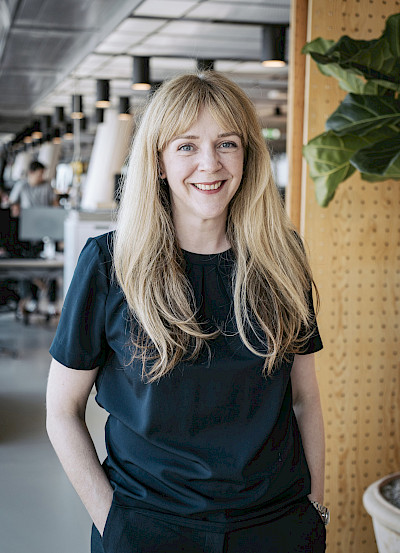
Sue Clark is senior sustainability advisor at Tengbom. Photo: Christoffer Skogsmo.
“If we had real workplaces outdoors right now, in the middle of this pandemic, they’d be very popular.”
The corona pandemic hit trade, social meeting places and the events sector hard when it seriously took hold in Sweden. Even though we’re still in its midst, it’s clear that cities will be used in new ways in the future. Municipalities and property owners will need to get creative and find new ways to make city centres more attractive and purposeful. A clear development is that companies are beginning to invest in outdoor environments in proximity or connection to their offices. And the trend has, in a short space of time, gone from work taking place inside the office, to more or less a new form of public coworking space — at first inside and now outside.
”Home is good in many ways, but it has its limitations when it comes to light, sound and air quality. It’s here where the office trumps the home. But it’s important that it has this and more to offer. With corona in our minds, we know we cannot sit close to one another but working outside, in nature, lies the answer,” explains Clark.
It’s not really news that being outside, exposed to nature, contributes to good health and mental wellbeing. That we can trace, if we wish, back to 355 BC, when Aristotle founded the Peripatetic School, where walking while learning was encouraged. Today, every other article is linked to working outside in some respect. Mankind’s affinity towards nature even has a name; Biophilia. This is beginning to spread as a method for companies to create attractive health-promoting workspaces by fusing outdoor attributes in internal spaces. Ironic, given that all we really need is to open the door and get out there.
Nola has furbished WorkOut, an outdoor office for Castellum’s tenants in Växjö, Sweden. Photo: Jonas Ljungdahl.
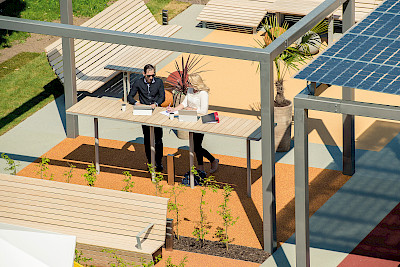
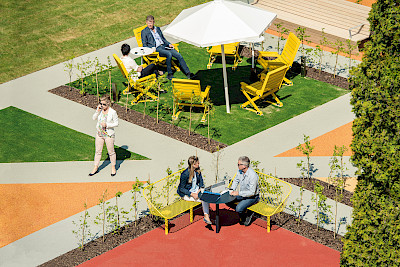
Working outdoors is hardly ever impossible, and no weather or clothing in the world can prevent anyone who wants to work in the open air from doing so. New research shows it’s more a case of bad conscious towards an employer for not being ’on site’ that gets in the way. We’re afraid of breaking the norm. Shaking off habits is always tough, something Charlotte Petersson Troije knows all about. Her dissertation work explores health-promoting aspects linked to taking work outside. In her guide Get Out! Your guide to working outdoors gives many examples of how to make work happen outside, including; Walk & Talk, Outdoor Meetings and Thought Walking. These and several forms of working outdoors are based on active exploration, where employees in the city of Malmö have tested and followed up a learning process over a period of 18 months.
A few pointers to make working outside more effective from the report Get Out!
Sue Clark agrees that the benefits of working in nature, outweigh any challenges. With the placement of outdoor furniture and dedicated workspaces being fundamental to efficiency and wellbeing. One has to also consider acoustics and air, to try and locate these spaces away from heavy traffic and the disruption they bring.
“Statistics show an upward trend of people dying prematurely as a direct consequence of air pollution, something we as architects, together with employers and property owners must take seriously. But the good thing is that nature is the answer to everything. Plants are one of the simplest and best solutions for counteracting the dangers of air and noise pollution,” Clark says.
“Nature is the answer to everything!”
Sue Clark, Tengboms
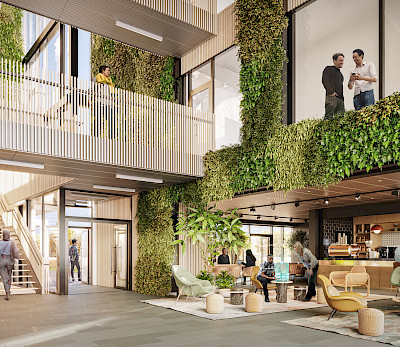
Eden is a pilot project by Kungsleden and the world’s first Symbiotic Building.
Forests, trees, plants and greenery are known to be a key ally in the fight against climate change, thanks to their ability to convert carbon dioxide into oxygen. In addition, the design of the surface of foliage has the ability to reflect sound — in other words, perfect for work environments in every way.
So can we just bring some plants into our homes and continue with ‘business as usual’ and work in front of the tv? Not really, according to Clark. In the long term, working from home isn’t a sustainable option, not the way houses are made today in any case.
“One of the biggest problems with the home office, and actually many other working environments, is the quality of air, which leads to fatigue and decline in motivation. As a result of climate change, things like heat waves are something we’re starting to encounter more often. And these make bring inside very uncomfortable indeed, due to poor thermal qualities of our buildings,” Clark notes.
The best we can do is demand more well-thought-out, dedicated places to work that are close to our homes, or part of the office where climate control is a central design attribute.
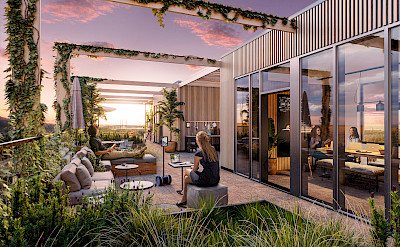
Eden by Kungsleden. The world’s first Symbiotic Building.
The outdoor office is definitely something we’ll see more of. In fact, as early as 2019, The New York Times called the phenomenon "the next frontier", even before the corona pandemic arrived. Charlotte Petersson Troije emphasises that there is one important aspect to bear in mind for the concept to work, and writes in the report: ’Because we are different, we need to develop forms of work that support us, and provides for all our different needs and preferences. It is not only important for the individual to feel and function well, it is also central to organisational fulfillment and efficiency, as well as contributing to sustainable development as a whole.’
In many ways, the employee is the winner, with the ability to choose between working inside or out. But even for the employer, there’s a huge win to be claimed to be able to offer prospective workers a dedicated green space from which to work. Something that really provides a point of distinction from the competition.
Are there challenges? Sure. Of course, weather is one thing that we in the north need to adapt to, but Sue Clark sees a silver lining there.
“There is a culture in Sweden where we sit outdoors a long time, even in the winter months, that we can translate to a green workspace.”
Could it affect the accessibility of our cities in a negative way? Sue Clark doesn’t think so.
“We’re involved in more and more projects and contexts where property owners are working with equality, diversity and accessibility to create urban environments that bring these aspects to the table to benefit tenants and those who use the spaces. And we see a great awareness from tenants who want and appreciate these kinds of workspaces. Certification systems like WELL set requirements for these kinds of environments, which is accelerating fast. We’re not yet at the point where outdoor furniture or spaces are certified according to its health benefits. But we’re probably not far off, the way things are progressing.” ●
“We’re not yet at the point where outdoor furniture or spaces are certified according to its health benefits. But we’re probably not far off, the way things are progressing.”